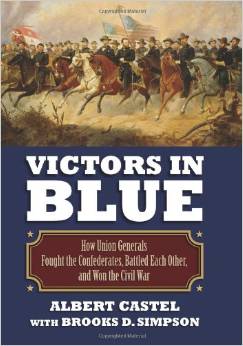Victors in Blue: How Union Generals Fought the Confederates, Battled Each Other, and Won the Civil War by Albert Castel with Brooks D. Simpson. University Press of Kansas, 2011. Cloth, ISBN: 9780700617937. $34.95.
 The story goes that when asked why the Confederates lost the Battle of Gettysburg, George Pickett replied that, “the Yankees had something to do with it.” Whatever the Confederacy did to lose the Civil War, its outcome was ultimately decided by what Union armies did to win it. In his most recent volume, the acclaimed historian Albert Castel reminds us of the decisive role that the North’s top generals played in achieving that final victory. At the same time, Castel’s pointed subtitle cautions us that those same victors spent much of the war warring against one another.
The story goes that when asked why the Confederates lost the Battle of Gettysburg, George Pickett replied that, “the Yankees had something to do with it.” Whatever the Confederacy did to lose the Civil War, its outcome was ultimately decided by what Union armies did to win it. In his most recent volume, the acclaimed historian Albert Castel reminds us of the decisive role that the North’s top generals played in achieving that final victory. At the same time, Castel’s pointed subtitle cautions us that those same victors spent much of the war warring against one another.
Castel describes the purpose of Victors in Blue as threefold: to offer succinct narratives of the campaigns and battles that led to Union victory; to analyze the generalship of the top Union field commanders; and to chronicle the “war within a war” that those generals fought amongst themselves. His prologue, “On Judging Civil War Generals,” aptly introduces the project, emphasizing that the North’s considerable material advantages made final victory “possible, but not inevitable.” The quality of generalship remained a critical factor, and Castel offers a five-point summary of his method of assessing generalship, which is itself a useful analytical tool for students of the Civil War.
What follows are eighteen chapters (the final five completed with input from Brooks D. Simpson) episodically chronicling key Union generals and their military achievements. Castel focuses primarily on the strategic and operational command levels, so readers will find few blow-by-blow tactical accounts of battles. Nevertheless, these chapters offer concise, well-written, and engaging retellings of major Union triumphs. Castel devotes his first chapter to the 1861 victories won in the mountains of western Virginia by George McClellan and William Rosecrans (mostly to the credit of the latter), a generally overlooked episode of the war on which the book sheds fresh light.
Castel is arguably at his finest, however, in recounting infighting among Union generals and narrating the war of words they waged in their correspondence. We learn of McClellan cheating Rosecrans out of the credit for winning the Battle of Rich Mountain; Henry Halleck’s machinations against Grant; William Tecumseh Sherman’s uncharitable assessment of John McClernand’s generalship at Shiloh; the mutual distrust between Grant and Rosecrans that developed as a result of the Battles of Iuka and Corinth; Rosecrans’ frustration with the repeated pressure from Washington to begin his 1863 offensive against Chattanooga; and sundry other flare-ups.
The heart of Victors in Blue is the author’s analysis and commentary. Castel suggests that some of his interpretations “are likely to be found novel, even outrageous,” although a number appear quite reasonable. He presents Grant as familiarly aggressive and dogged, though not above seemingly petty squabbles with fellow officers. Henry “Old Brains” Halleck appears at his meddlesome and backbiting best, though not completely lacking in talent. Castel indulges in an unrestrained and richly deserved critique of George McClellan’s supreme caution — and supreme arrogance. Much of this Castel accomplishes by repeating McClellan’s own grandiose pronouncements, though he adds his own parting shot, marking “Little Mac” as “a man divorced from reality by a combination of megalomania and paranoia.”
Quite likely, the most controversial contribution of Victors in Blue will prove to be the vigorous apologia for William Starke Rosecrans. Castel convincingly presents “Old Rosy” as a brave, capable, and intelligent commander — faulting him only for wielding too acerbic a pen when writing to his superiors. Considering that Castel welcomes the “passionate dissent” that the book may provoke, he certainly will not begrudge an honest critique of his championship of Rosecrans, which errs in overlooking more regrettable episodes in his military career. Castel, for instance, does not fault the general for overextending his weak defenses at Corinth, which set the stage for a successful Confederate assault on the Union left and nearly cost his troops the battle. Nor does he address accounts of Rosecrans’ battlefield histrionics at Corinth, wild and erratic behavior that seemed only to foreshadow his apparent instability in the wake of his defeat at Chickamauga the following year. Castel likewise errs in special pleading for Rosecrans, celebrating his largely bloodless outmaneuvering of Braxton Bragg in the Tullahoma Campaign, yet slighting William Sherman for capturing the empty city of Atlanta without bagging Hood’s Army of Tennessee — an accomplishment Castel somewhat uncharitably compares with one of McClellan’s hollow victories.
Foibles aside, this book has much to commend it. Albert Castel offers concise and accessible narratives of the major battles and campaigns of the Union war effort, engaging examinations of the feuds and rivalries within the Union high command, and bold arguments with the potential to foster spirited debate among scholars and buffs. If other readers recognize these qualities in Victors in Blue, then Castel can be well pleased with his latest contribution to Civil War history.
Jonathan M. Steplyk is a Ph.D. candidate in History at Texas Christian University and has worked as a seasonal ranger at Cedar Creek and Belle Grove National Historical Park.